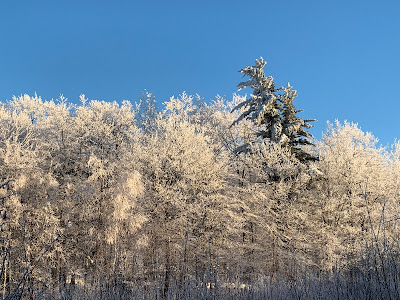 |
| Trees in St. Albans, Vermont on February 4 after a snowstorm. The chilly photo, however, is opposite the theme of what was a warm 2021 in the Green Mountain State. |
Thankfully, Vermont managed to avoid the huge weather disasters that plagued so many parts of the world during 2021. Let's hope our luck holds on through 2022 and beyond.
Even without those extremes, there was plenty to talk about with the weather during the course of the year.
Here are some of the top weather events:
You don't think of drought in the depths of winter, but much of Vermont was still in a drought during January, 2021
Mid February: Vermont and New England are one of the few places in the nation to escape the historic cold wave that froze Texas, the rest of the South and most of the Midwest. The coldest temperature in Burlington during this was minus 5, which is not unusual for mid-February.
March 11: Record high of 64 degrees in Burlington, bested the old record set in 1977 by eight degrees.
March 25: Record high of 73 degrees in Burlington, beat the record of 68 set in 1996.
March 26: The now-famous Middlebury tornado hit with top winds of 110 mph. It was 75 yards wide and traveled about a mile. It severely damaged one home and more lightly damaged a handful of others. It had a rating of EF-1.
 |
| An intense snow squall in St. Albans, Vermont on April 22. This interruption to what had been a very early spring damaged early spring plants and flowers. |
April 21-22: Snow and cold interrupted an otherwise warm month. Accumulations included 8.8 inches in Greensboro, 8 inches in Hardwick, 7.4 inches in Jericho and 5 inches in St. Albans. Subfreezing temperatures, strong winds and thick snow squalls on April 22 damaged spring buds and flowers that had gotten an early start in unseasonably warm weather early in the month.
May 20-21: Back to record highs, with a 92 degree reading in Burlington. Warm, dry weather through the spring raised drought worries, and contributed to a forest fire that lasted several days in Killington
May 28-31 Late season cold. Snow accumulated an inch or two atop the higher peaks of the southern Green Mountains. A hard freeze was reported in the cold hollows of northern Vermont: 27 degrees in Island Pond, 28 in Gallup Mills and 30 in Eden.
June 6-7 A quick rebound to record heat. Temperature reached a record high of 95 degrees in Burlington on the sixth, and a record 96 on the 7th. That 96 degree reading was the hottest for so early in the season.
 |
| A warm, dry spring contributed to a gypsy moth caterpillar infestation that deforested huge swaths of Vermont forests. |
July 18. Flooding hit southeastern Vermont as up to five inches of rain fell overnight. Several roads were washed out, and numerous basements in Brattleboro reportedly flooded. i
July 20 and Aug 6: Vermont endured two episodes of thick wildfire smoke from western and Canadian forest fires. Visibility fell to as little as two or three miles and air pollution alerts were in effect for the state on these days.
Aug. 26 A strong to severe thunderstorm stalled for at least six hours over central Vermont, near Hancock and Granville. Thankfully the bulk of it stalled over a remote area so flash flooding did not cause widespread damage. The storm put on an extended evening light show visible up to 100 miles away.
 |
| Street flooding in Burlington, Vermont after strong to severe thunderstorms on September 8 |
Sept. 15. A second round of severe thunderstorms hit central and southern Vermont, with tree and wire damage extending from Rutland County to the central Connecticut River Valley. Four inches of rain in Bennington County caused some flash flooding.
Oct. 16. Severe late season thunderstorms prompted worries about tornado spin-ups in the region, which is awfully late in the season for that. Although there was some minor tree damage from straight line winds, no tornadoes are known to have touched down. .....
Oct 31: October was the fourth warmest on record in Burlington.
Dec. 16-17: Record Vermont warmth amid nationwide record warmth. Burlington reached 61 degree and Montpelier achieved 63. It was still warm in the pre-dawn hours of Dec. 17 as Burlington had s record high of 60 degrees just after midnight.

No comments:
Post a Comment